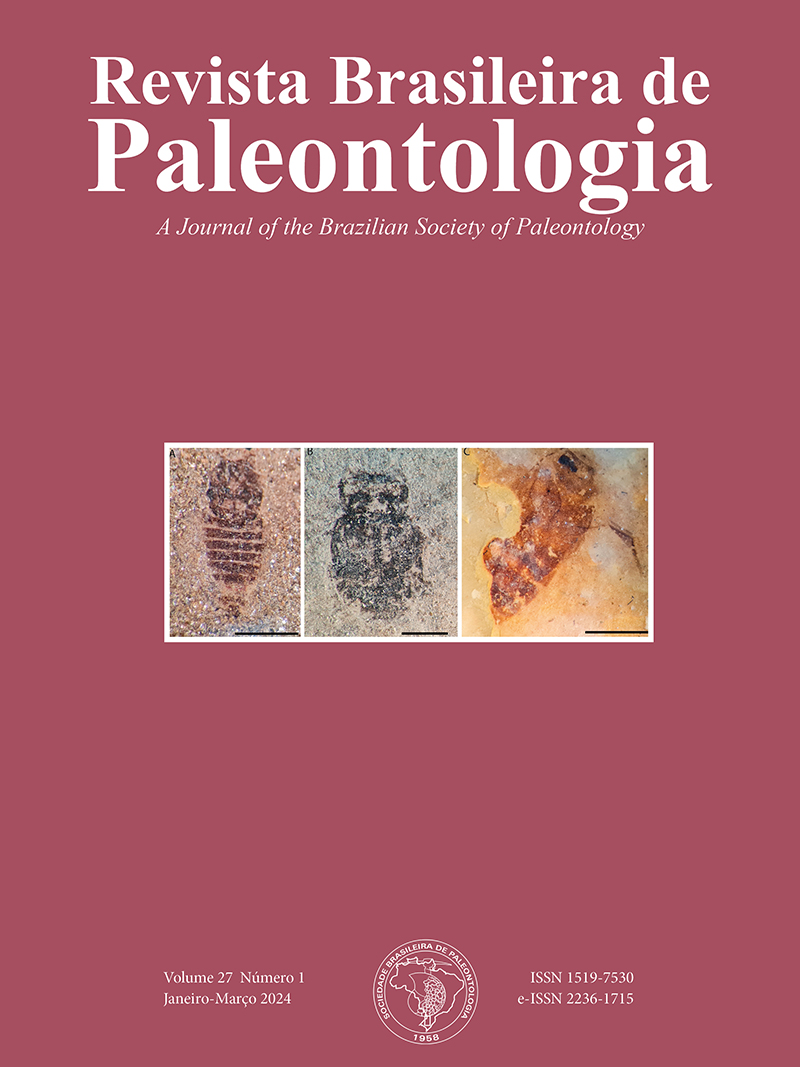Eocene larger benthic Foraminifera from the Jahrum Formation (Kalbibak Section, Boldaji Region) in High Zagros, Iran: an approach on paleontology and biostratigraphy
DOI:
https://doi.org/10.4072/rbp.2024.1.0417Resumo
The Jahrum Formation is a major Eocene carbonate deposit of High Zagros in the west of Iran. It consists of thin bedded to thick massive limestone, accumulated on a shallow marine platform within the Neo-Tethys Ocean realm. Fifty-five surface samples were collected throughout a 215 m section in the Kalbibak area (Boldaji region, Chahar Mahal Bakhtiari province). The stratigraphic distribution of benthic foraminifers allows characterizing five foraminiferal biozones, which are in the following order: Alveolina aff. schwageri Taxon Range Zone, A. decastroi Taxon Range Zone, A. aff. frumentiformis–A. cf. stercusmuris Interval Zone, A. aff. stercusmuris–A. aff. fusiformis Interval Zone and Nummulites–Alveolina Assemblage Zone. The benthic foraminiferal associations in the studied area are similar to those
recorded in Tethys realms and enable us to correlate the Jahrum Formation with the early to middle Eocene.
Keywords: benthic foraminifers, biostratigraphy, Jahrum Formation, Kalbibak section, West Iran.
Resumo – A Formação Jahrum é um importante depósito de carbonato do Eoceno do Alto Zagros, no oeste do Irã. Ela consiste em calcário maciço de leito fino a espesso, acumulado em uma plataforma marinha rasa dentro do domínio do Oceano Neo-Tethys. Cinquenta e cinco amostras de superfície foram coletadas em uma seção de 215 m na área de Kalbibak (região de Boldaji, província de Chahar Mahal Bakhtiari). A distribuição estratigráfica dos foraminíferos bentônicos permite caracterizar cinco biozonas de foraminíferos, que estão na seguinte ordem: Zona de Amplitude do Táxon Alveolina aff. schwageri, Zona de Amplitude do Táxon A. decastroi, A. aff. frumentiformis–Zona de intervalo A. cf. stercusmuris, A. aff. stercusmuris–Zona de intervalo A. aff. fusiformis e Zona de Associação Nummulites–Alveolina. As associações de foraminíferos bentônicos na área estudada são semelhantes às registradas nos domínios do Tethys e nos permitem correlacionar a Formação Jahrum com o Eoceno inicial a médio.
Palavras-chave: foraminíferos bentônicos, bioestratigrafia, Formação Jahrum, seção Kalbibak, Irã ocidental.
Downloads
Downloads
Publicado
Como Citar
Edição
Seção
Licença
Copyright (c) 2024 Revista Brasileira de Paleontologia

Este trabalho está licenciado sob uma licença Creative Commons Attribution 4.0 International License.
This is an Open Access article distributed under the terms of the Creative Commons Attribution-NonCommercial-NoDerivatives license (http://creativecommons.org/licenses/by-nc-nd/4.0), which permits non-commercial re-use, distribution, and reproduction in any medium, provided that no alterations are made and the original article is properly cited. The written permission of Revista Brasileira de Paleontologia must be obtained before any commercial use and/or adaptation of the article.







